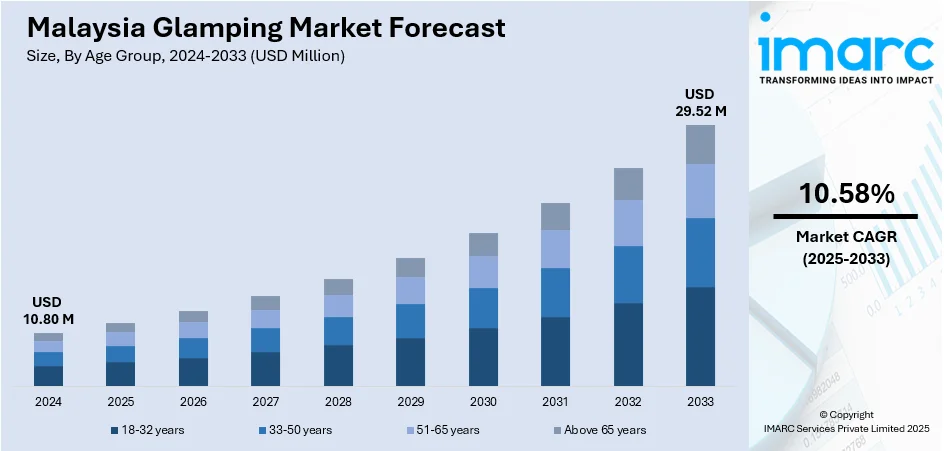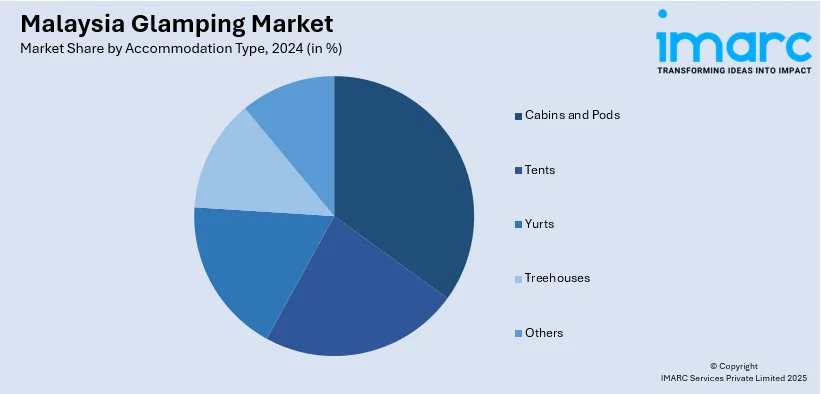
Malaysia Glamping Market Size, Share, Trends and Forecast by Age Group, Accommodation Type, Booking Mode, and States, 2025-2033
Malaysia Glamping Market Overview:
The Malaysia glamping market size reached USD 10.80 Million in 2024. The market is projected to reach USD 29.52 Million by 2033, exhibiting a growth rate (CAGR) of 10.58% during 2025-2033. The market is propelled by a rising preference for experiential travel, growing domestic tourism among young professionals, and increasing government support for sustainable tourism initiatives. Moreover, inflating disposable incomes and a desire for unique outdoor stays have encouraged investors to develop innovative glamping sites across the country. Also, enhanced infrastructure and targeted marketing campaigns contribute to steady demand in both local and international segments, which further augments Malaysia glamping market share.
|
Report Attribute
|
Key Statistics
|
|---|---|
|
Base Year
|
2024
|
|
Forecast Years
|
2025-2033
|
|
Historical Years
|
2019-2024
|
| Market Size in 2024 | USD 10.80 Million |
| Market Forecast in 2033 | USD 29.52 Million |
| Market Growth Rate 2025-2033 | 10.58% |
Malaysia Glamping Market Trends:
Growth in Domestic and Inbound Tourism
A major trend shaping the market is the steady rise in both domestic and inbound tourism. Over recent years, Malaysia’s appeal as an accessible and diverse destination has attracted a wider mix of travelers looking for unique outdoor experiences. As per industry reports , more than 25 million international travelers visited Malaysia in 2024. This steady influx of travelers has strengthened the demand for distinctive accommodation options that move beyond conventional hotels and resorts. International visitors, especially from neighboring ASEAN countries, are also showing a stronger interest in alternatives to traditional hotels, favoring novel stays that combine comfort with immersion in nature. Moreover, the government’s tourism initiatives, including campaigns such as “Cuti-Cuti Malaysia,” have successfully encouraged locals to explore lesser-known destinations within the country, driving up demand for nature-based accommodations like glamping. Besides, improved road connectivity to forest reserves, coastal zones, and highland areas supports this demand, making once-remote sites reachable for weekend trips. Also, festivals, eco-tourism trails, and regional tourism collaborations further add to footfall. This consistent inflow provides operators with the confidence to expand capacity, experiment with new site designs, and invest in amenities that appeal to both repeat domestic guests and first-time international visitors seeking distinctive stays.

To get more information on this market, Request Sample
Expansion of Digital Booking and Flexible Reservations
The ease of online booking has become an important driver for Malaysia glamping market growth as travelers increasingly expect quick, convenient ways to secure unique stays. Many operators now partner with major online travel agencies (OTAs) and listing platforms to widen visibility and attract digital-savvy audiences. User-friendly websites and mobile apps allow customers to view high-resolution images, check real-time availability, compare tent options, and read verified reviews before committing to a reservation. In addition to this, flexible booking policies, including last-minute deals and free cancellation, have gained popularity, giving travelers peace of mind when plans change. Also, 5G adoption expanded rapidly, rising from 6.7% of total connections in the first quarter of 2023 to 41.9% by the end of 2024. Broader 5G coverage has improved internet reliability and speed in semi-rural and remote areas, making digital booking and online promotions for glamping sites far more effective. Furthermore, operators benefit from greater reach to independent travelers and groups planning short escapes, especially urban residents seeking quick weekend breaks. The digital shift also enables providers to collect booking data and feedback, which helps them adjust promotional strategies and develop offers that match customer behavior and seasonal demand.
Malaysia Glamping Market Segmentation:
IMARC Group provides an analysis of the key trends in each segment of the market, along with forecasts at the country and regional levels for 2025-2033. Our report has categorized the market based on age group, accommodation type, and booking mode.
Age Group Insights:
- 18-32 years
- 33-50 years
- 51-65 years
- Above 65 years
The report has provided a detailed breakup and analysis of the market based on the age group. This includes 18-32 years, 33-50 years, 51-65 years, and above 65 years.
Accommodation Type Insights:

- Cabins and Pods
- Tents
- Yurts
- Treehouses
- Others
A detailed breakup and analysis of the market based on the accommodation type have also been provided in the report. This includes cabins and pods, tents, yurts, treehouses, and others.
Booking Mode Insights:
- Direct Booking
- Travel Agents
- Online Travel Agencies
The report has provided a detailed breakup and analysis of the market based on the booking mode. This includes direct booking, travel agents, and online travel agencies.
States Insights:
- Selangor
- W.P. Kuala Lumpur
- Johor
- Sarawak
- Others
The report has also provided a comprehensive analysis of all the major regional markets, which include Selangor, W.P. Kuala Lumpur, Johor, Sarawak, and others.
Competitive Landscape:
The market research report has also provided a comprehensive analysis of the competitive landscape. Competitive analysis such as market structure, key player positioning, top winning strategies, competitive dashboard, and company evaluation quadrant has been covered in the report. Also, detailed profiles of all major companies have been provided.
Malaysia Glamping Market News:
- On June 12, 2024, Paya Beach Spa & Dive Resort on Tioman Island, Malaysia, announced the launch of a new luxury “glamping by the river” experience beginning in September 2024. The offering includes bespoke glamping suites for up to six guests, complete with ensuite pools, private balconies, hammocks, air conditioning, and smart amenities like TVs and smart mirrors. Guests will also enjoy access to a variety of outdoor adventures such as snorkeling, diving, kayaking, trekking, yoga, and ATV rides—combining modern comfort with immersive natural experiences.
Malaysia Glamping Market Report Coverage:
| Report Features | Details |
|---|---|
| Base Year of the Analysis | 2024 |
| Historical Period | 2019-2024 |
| Forecast Period | 2025-2033 |
| Units | Million USD |
| Scope of the Report |
Exploration of Historical Trends and Market Outlook, Industry Catalysts and Challenges, Segment-Wise Historical and Future Market Assessment:
|
| Age Groups Covered | 18-32 years, 33-50 years, 51-65 years, Above 65 years |
| Accommodation Types Covered | Cabins and Pods, Tents, Yurts, Treehouses, Others |
| Booking Modes Covered | Direct Booking, Travel Agents, Online Travel Agencies |
| States Covered | Selangor, W.P. Kuala Lumpur, Johor, Sarawak, Others |
| Customization Scope | 10% Free Customization |
| Post-Sale Analyst Support | 10-12 Weeks |
| Delivery Format | PDF and Excel through Email (We can also provide the editable version of the report in PPT/Word format on special request) |
Key Questions Answered in This Report:
- How has the Malaysia glamping market performed so far and how will it perform in the coming years?
- What is the breakup of the Malaysia glamping market on the basis of age group?
- What is the breakup of the Malaysia glamping market on the basis of accommodation type?
- What is the breakup of the Malaysia glamping market on the basis of booking mode?
- What is the breakup of the Malaysia glamping market on the basis of states?
- What are the various stages in the value chain of the Malaysia glamping market?
- What are the key driving factors and challenges in the Malaysia glamping market?
- What is the structure of the Malaysia glamping market and who are the key players?
- What is the degree of competition in the Malaysia glamping market?
Key Benefits for Stakeholders:
- IMARC’s industry report offers a comprehensive quantitative analysis of various market segments, historical and current market trends, market forecasts, and dynamics of the Malaysia glamping market from 2019-2033.
- The research report provides the latest information on the market drivers, challenges, and opportunities in the Malaysia glamping market.
- Porter's five forces analysis assist stakeholders in assessing the impact of new entrants, competitive rivalry, supplier power, buyer power, and the threat of substitution. It helps stakeholders to analyze the level of competition within the Malaysia glamping industry and its attractiveness.
- Competitive landscape allows stakeholders to understand their competitive environment and provides an insight into the current positions of key players in the market.
Need more help?
- Speak to our experienced analysts for insights on the current market scenarios.
- Include additional segments and countries to customize the report as per your requirement.
- Gain an unparalleled competitive advantage in your domain by understanding how to utilize the report and positively impacting your operations and revenue.
- For further assistance, please connect with our analysts.
 Request Customization
Request Customization
 Speak to an Analyst
Speak to an Analyst
 Request Brochure
Request Brochure
 Inquire Before Buying
Inquire Before Buying




.webp)




.webp)












